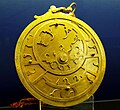 Whipple Museum of the History of Science, in Free School Lane, Cambridge | |
 | |
| Established | 1944 |
|---|---|
| Location | Cambridge |
| Coordinates | 52°12′00″N0°07′12″E / 52.20000°N 0.12000°E |
| Type | University Museum |
| Accreditation | Arts Council England accredited |
| Collections | Scientific instruments, apparatus, models, pictures, prints, photographs, books and other material related to the history of science |
| Visitors | 11,845 (2019) [1] |
| Founder | Robert Whipple |
| Director | Dr Joshua Nall |
| Owner | University of Cambridge |
| University of Cambridge Museums | |
The Whipple Museum of the History of Science is a museum attached to the University of Cambridge, England, which houses an extensive collection of scientific instruments, apparatus, models, pictures, prints, photographs, books and other material related to the history of science. It is located in the former Perse School on Free School Lane, Cambridge. The museum was founded in 1944, when Robert Whipple presented his collection of scientific instruments to the University of Cambridge. The museum's collection was 'designated' by the Museums, Libraries and Archives Council (MLA) as being of "national and international importance". [2]
Contents
- Department of History and Philosophy of Science
- Collections
- Opening hours
- Gallery
- See also
- References
- External links
The museum is one of eight museums in the University of Cambridge Museums consortium. [3]



